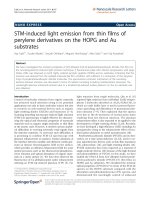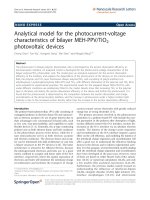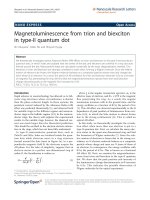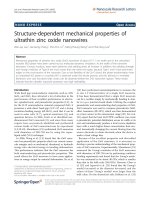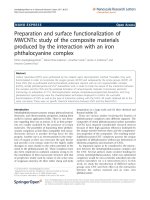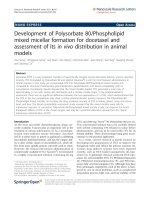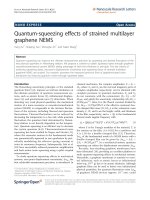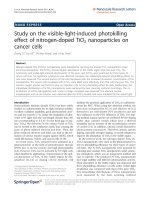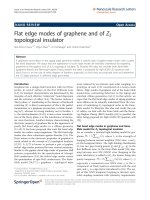Saika et al. AMB Express 2011, 1:6 http://www.amb-express.com/content/1/1/6 ORIGINAL Open doc
Bạn đang xem bản rút gọn của tài liệu. Xem và tải ngay bản đầy đủ của tài liệu tại đây (308.15 KB, 8 trang )
ORIGINAL Open Access
Enhanced Incorporation of 3-Hydroxy-4-
Methylvalerate Unit into Biosynthetic
Polyhydroxyalkanoate Using Leucine as a
Precursor
Azusa Saika
1
, Yoriko Watanabe
1
, Kumar Sudesh
2
, Hideki Abe
3
and Takeharu Tsuge
1*
Abstract
Ralstonia eutropha PHB
-
4 expressing Pseudomonas sp. 61-3 polyhydroxyalkanoate (PHA) synthase 1 (PhaC1
Ps
)
synthesizes PHA copolymer containing 3-hydroxybutyrate (3HB) and a small amount (0.5 mol%) of 3-hydroxy-4-
methylvalerate (3H4MV) from fructose as a carbon source. In this study, enhanced incorporation of 3H4MV into
PHA was investigated using branched amino acid leucine as a precursor of 3H4MV. Leucine has the same carbon
backbone as 3H4MV and is expected to be a natural and self-producible precursor. We found that the
incorporation of 3H4MV was enhan ced by the supplementation of excess amount (10 g/L) of leucine in the culture
medium. This findin g indicates that 3H4MV can be derived from leucine. To increase metabolic flux to leucine
biosynthesis in the host strain by eliminating the feedback inhibition, the cells were subjected to N-methyl-N’-nitro-
N-nitrosoguanidine (NTG) mutagenesis and leucine analog resistant mutants were generated. The mutants showed
statistically higher 3H4MV fraction than the parent strain without supplementing leucine. Additionally, by supplying
excess amount of leucine, the mutants synthesized 3HB-based PHA copolymer containing 3.1 mol% 3H4MV and
1.2 mol% 3-hydroxyvalerate (3HV) as minor constituents, which significantly affected the thermal properties of the
copolymer. This study demon strates that it is possible to enhance the monomer supply of 3H4MV into PHA by
manipulating leucine metabolism.
Keywords: polyhydroxyalkanoate copolymer, 3H4MV precursor, leucine analog resistant mutant
Introduction
Polyhydroxyalkanoate (PHA) is a kind of aliphatic polye-
ster synthesized by a wide variety of microorganisms as
intracellular storage and carbon source (Sudesh et al.
2000). It can be biosynthesized from renewable carbon
sources such as sugars and plant oi ls, and can be com-
pletely biodegraded in the environment. PHA is
expected to solve some environmental problems such
as, exce ss emission of carbon dioxide, depletion of pet-
roleum and environment pollution by waste plastics.
Poly[(R)-3-hydroxybutyrate], P(3HB), is the most
common PHA that bacteria synthesize. However, P
(3HB) is a brittle and rigid material with low flexibility
because of its high crystallinity (Sudesh et al. 2000).
Thus, the application of P(3HB) is limited. The
mechanical properties of P(3HB) can be effectively
improved by copolymerization with (R)-3-hydroxyalk-
anoate (3HA) monomers having bulky side chains such
as (R)-3-hydroxyvalerate (3HV) (Bloembergen et al.
1986; Lee et al. 19 96; Steinbüchel and Pieper 1992),
(R)-3-hydroxyhexanoate (3HHx) (Fukui and Doi 1997;
Shimamura et al. 1994; Tsuge et al. 2004) and longer
3HA (Matsusaki et al. 2000; Singh and Mallick 2009).
The incorporation of such 3HA monomers lowers the
crystallinity of 3HB-based copolymers due to obstacle
by bulky side chain. In addition, the melting tempera-
ture of copolymer decreases with an increase in the
fraction of bulky 3HA, whereas elongation at break is
markedly increased (Sudesh et al. 2000). The incor-
poration of comonomers into P(3HB) sequence
* Correspondence:
1
Department of Innovative and Engineered Materials, Tokyo Institute of
Technology, 4259 Nagatsuta, Midori-ku, Yokohama 226- 8502, Japan
Full list of author information is available at the end of the article
Saika et al . AMB Express 2011, 1:6
/>© 2011 Saika; licensee Springer. This is an Open Access article distributed under the terms of the Creative Commons Attribution
License (http://creativecommons. org/licenses/by/2.0), which permits unrestricted use, distribution, and reproduction in any medium,
provided the original work is properly cited.
depends on the substrate specificity of the polymeriz-
ing enzyme, PHA synthase (PhaC). To date, many
PhaC genes (phaC)havebeenclonedfromvarious
microorganisms and the gene products were character-
ized partially (Rehm 2003). In particular, the PHA
synthase of Pseudomonas sp. 61-3 (PhaC1
Ps
)has
attracted much attention because of its unique sub-
strate specificity towards 3HA monomers with chain
lengths of 4-12 carbon atoms (Matsusaki et al. 1998,
2000). Pseudomonads have several PhaCs with differ-
ent substrate specificity. Since the other PhaCs from
pseudomonads are unable to polymerize 3HB unit,
PhaC1
Ps
has been useful for the synthesis of 3HB-
based PHA copolymer incorporating various types of
3HA.
Recently, it was shown that Ralstonia eutropha (cur-
rently designated Cupriavidus necator)strainPHB
-
4
expressing phaC1
Ps
hastheabilitytoproduceanew
type of PHA copolymer containing branched monomer
unit, termed 3-hydroxy-4-methylvalerate (3H4MV, Fig-
ure 1a), from fructose as the sole carbon source (Tanad-
changsaeng et al. 2009, 2010). Both 3H4MV and 3HHx
are i somers that differ only in the side chain structure,
whereby 3H4MV has an iso-propyl group as the side
chain whereas 3HHx has an n-propyl group. Therefore,
P(3HB-co-3H4MV) and P(3HB-co-3HHx) copolymers
showed similar mechanical and thermal properties
(Tanadchangs aeng et al. 2009, 2010). The 3H4M V frac-
tion of PH A produced fro m fructose by R. eutropha
PHB
-
4expressingphaC1
Ps
was only 0.5 mol%, but it
can be increased up to 46 mol% by feeding 4-methylva-
lerate (4MV) as a 3H4MV precursor. However, since
4MV is a costly and toxic precursor, an alternative
method to produce P(3HB-co-3H4MV)fromabundant
and inexpensive renewable resources is desirable.
In this study, PHA containing 3H4MV unit was
synthesized by R. eutropha PHB
-
4 expressing phaC1
Ps
from fructo se with or without the addition of branched
amino acid, leucine, as a precursor of 3H4MV unit.
Because l eucine has the same carbon backbone as
3H4MV (Figure 1b), it is expected to be useful as a nat-
ural metabolite precursor of 3H4MV. In addition,
mutants that are resistant to leucine analog were gener-
ated by random chemical mutagenesis and characterized
for their ability to incorporate 3H4MV into PHA. This
study demonstrates for the first time that it is possible
to enhance the monomer supply of 3H4MV into PHA
by manipulating leucine metabolism.
Materials and methods
Bacterial strains and plasmid
PHA-negative mutant R. eutropha PHB
-
4 (DSM541) was
employed as host strain for PHA synthesis (Schlegel et
al. 1970). The recombinant plasmid pB BR1"C1
Ps
AB
Re
containing PHA synthase gene from Pseudomonas sp.
61-3 (phaC1
Ps
) and monomer s upplying enzyme genes
from R. eutropha (phaAB
Re
) was transformed into the
host strain by transconjugation (Tsuge et al. 2005). Leu-
cine analog resistant mutants of R. eutropha PHB
-
4
were generated according to the method described
below.
Generation of leucine analog resistant mutants
R. eutropha PHB
-
4 expressing phaC1
Ps
was grown in 1.7
mL Nutrient-Rich (NR) medium (10 g of Bacto trypton,
2 g of yeast extract and 10 g of meat ex tract per liter of
distilled water) with 50 μg/mL kanamycin at 30°C for 24
h. The cells were harvested by centrifugation and then
suspended in 2.5 mL potassium phosphate buffer (100
mM, pH 7.0). Suspended cells were treated with 10 μL
N-methyl-N’-nitro-N-nitrosoguanidine (NTG, 10 mg/mL
stock solution of dimethyl sulfoxide) for 30 min at 30°C.
NTG treated cells were harvested and washed three
times with NR medium. Then, the cells were resus-
pended in NR medium and 100 μL cell suspended solu-
tion was inocula ted into 1.7 mL NR medium containing
50 μg/mL kanamycin and cultivated at 30°C for 24 h.
The recovered cells were spread on agar plate of mineral
salt (MS) medium (9 g of Na
2
HPO
4
·12H
2
O, 1.5 g of
KH
2
PO
4
,0.5gofNH
4
Cl, 0.2 g of MgSO
4
·7H
2
Oand1
mL of trace element solut ion per liter of distilled water)
(Kato et al. 1996) containing 1.5 g/L 4-aza-DL-leucine
dihydrochloride (Sigma Aldrich, St Louis, MO, USA,
Figure 1c) as a leucine analog. After 2 days of incuba-
tion, colonies appeared on the selective agar plate which
showed resistance to the leucine analog.
HPLC assay of 3H4MV content in mutants
The 3H4MV content in leucine analog resistant mutants
was measured by high-performance liquid chromatogra-
phy (HPLC). Leucine a nalog resistant mutants were
ino culated into 600 μL MS medium supplemented with
20 g/L fructose and 50 μg/mL kanamycin in 1.2 mL
wells of 96 well plate. A fter sealing the plate with an air
x
3HB
3H4MV3HV
OOO
OOO
a
b
O
OH
NH
2
c
O
OH
NH
2
N
Figure 1 Structures of (a) P(3HB-co-3HV-co-3H4MV), (b) leucine,
and (c) 4-azaleucine (leucine analog).
Saika et al . AMB Express 2011, 1:6
/>Page 2 of 8
permeable film, the mutants were cultivated at 30°C for
72 h by shaking in a reciprocal shaker (130 strokes/
min). At the end of the cultivation period, the superna-
tant was discarded after the mutant cells were pelleted
by centrifugation. Finally, t he cell pellets in the 96-well
plate were dried at 55°C for 3 days.
The sample for HPLC assay was prepared by alkaline
treatment, the details of which are to be published else-
where. The method is briefly described here. The dried
cell pellets were treated with 200 μLof1NNaOHat
100°C for 3 h in a 96-well plate hermetically heat-sealed
by polypropylene/aluminum film. The plate was then
cooled to room temperature before adding 200 μLof
1N HCl to the cell lysate for neutralization. T his sample
was filtered using a 0.45 μm pore sized PTFE membrane
filter plate, and the filtrates were collected into a new
96-well plate. By the alkaline treatmen t, the hydrolyzed
3HAs were converted to the corresponding trans-2-alke-
noic acids.
HPLC analysis was performed using an LC-10Avp sys-
tem (Shimadzu, Kyoto, Japan) with an ion-exclusion col-
umn, Fast Acid Analysis (100 mm × 7.8 mm I.D., Bio-
Rad, Hercules, CA, USA), at 60°C. H
2
SO
4
(0.01 4N) with
12% CH
3
CNwasusedasthemobilephaseataflow
rate of 0.7 mL/min. The chromatograms were recorded
at 210 nm by a UV detector because trans-2-alkenoic
acids have strong UV absorption.
PHA biosynthesis
R. eutropha PHB
-
4 expressing phaC1
Ps
and its leucine
analog resistant mutants were cultured in a 500-mL shak-
ing flask (130 strokes/min) containing 10 0 mL MS med-
ium, in which nitrogen source is limited for cell growth as
described above, supplemented with 20 g/L fructose at 30°
C for 72 h. In all cases, 50 μg/mL kanamycin was added to
the medium to maintain the plasmid stability. Five amino
acids, L-leucine (L-Leu), L-valine (L-Val), L-isoleucine (L-
Ile), L-threonine (L-Thr, Kanto Chemical, Tokyo, Japan)
and D-leucine (D-Leu, Wako Pure Chemical, Osaka,
Japan), were supplemented into MS medium to examine
their ability to function as 3H4MV precursor. The culti-
vated cells were harvested by centrifugation and washed
with distilled water to remove the medium components
before being lyophilized.
PHA analyses
PHA contents and composition were determined by gas
chromatography (GC14B, Shimadzu, Kyoto, Japan) with
flame ionization detector and gas chromatography-mass
spectrometry (GCMS-QC 2010, Shimadzu, Kyoto,
Japan). Approximately 30 mg lyophilized cells were
methanolyzed in the presence of 15% sulfuric acid
before analysis (Kato et al. 1996).
PHA was extracted from lyop hilized cells with chloro-
form at room temperature, and purified by reprecipita-
tion into methanol. Molecular weight was determined
by gel permeation chromatography (10A GPC system,
Shimazdu, Kyoto, Japan). Approximately 1 mg extract ed
polymer was dissolved in 1 mL chloroform, and a na-
lyzed at a column temperature of 40°C. Polystyrene
standards with a low polydispersity were used to make
the calibration curve.
PHA f ilms for thermal analysis were prepared by sol-
vent casting method. For this, the extracted and purified
PHA was dissolved in chloroform and the polymer solu-
tion was poured into Petri dishes. The solvent was eva-
porated at room temperature and then the films were
aged for at least three weeks to reach equilibrium crys-
tallinity prior to analysis. For differential scanning
calorimetric analysis, 2-3 mg of the PHA film was
encapsulated in aluminum pans and analyzed with a
Perkin-Elmer Pyris 1 DSC (Perkin-Elmer, Waltham,
MA, USA) in the temperature range of -50 to 200°C at
a heating rate of 20°C/min under nitrogen atmosphere.
Results
Effect of Amino Acid Supplementation on 3H4MV
Fraction
Because the carbon back bone of 3H4MV is the same as
that of branched amino acid leucine (Figure 1), we
expected that leucine and its structurally related amino
acids could functio n as 3H4MV precursors. To evaluate
the feasibility of 3H4MV provision from amino acids, R.
eutropha PHB
-
4 expressing phaC1
Ps
was cultivated in
MS plus fructose medium supplemented with 10 g/L of
various amino acids. Table 1 shows the result of cul tiva-
tion. The dry cell weights increased with t he additio n of
amino acids except for L-valine and D-leucine. L-Valine
has been u sed for PHA production (Fujita et al. 1993,
Kimura et al. 2003); however, effect of high concentra-
tion of L-valine (10 g/L) on the cell growth has not
been reported previously. L-Isoleucine is known to func-
tion as a 3HV precursor in R. eutropha (Steinbüchel and
Pieper 1992). Our result also showed that the addition
of L-isoleucine enh anced the 3HV fraction to 7.7 mol%.
The same effect was also demonstrated by L-threonine
(Steinbüchel and Pieper 1992), but no enhancement of
3HV was seen in our study. As for 3H4MV, a very small
amount of 3H4MV (0.5 mol%) was incorporated into
PHA when no a mino acids were supplemented. Supple-
mentation of L-isoleucine and L-threonine also showed
no effect on 3H4MV enhancement. However, L-leucine
supplementation showed a slightly increased 3H4MV
fraction (0.9 mol%), suggesting that L-leucine (herein-
after referred to as leucine) is a potent candidate of
3H4MV precursor.
Saika et al . AMB Express 2011, 1:6
/>Page 3 of 8
PHA Production by Leucine Analog Resistant Mutants
From the result of leucine supplementation, i t was
speculated that 3H4MV provision might be increased by
increasing the metabolic flux to leucine biosynthesis,
without the use of 3H 4MV precursor. However, leucine
biosynthesis pathway i s known to be strictly regulated
by end product feedback inhibition. To eliminate the
feedback inhibition, we aimed to generate leucine analog
resistant mutants of R. eutropha PHB
-
4 harboring
phaC1
Ps
by NTG mutagenesis, using the same approa ch
that was used for the generation of L-leucine producers
of E. coli. (Nakano et al. 1996)
More than a thousand leucine analog resistant
mutants of R. eutropha PHB
-
4harboringphaC1
Ps
were
generated by the mutagenesis. These mut ants were cul-
tured in 96-deep well plate with MS medium plus fruc-
tose as a sole carbon source to analyze the P HA
composition by high-throughput HPLC. As a result, 440
leucine analog resistant mutants accumulated detectable
amount of PHA. Figure 2 shows the comparison of aver-
age 3H4MV fractions between R. eutropha PHB
-
4
expressing phaC1
Ps
(parent strain) and leucine analog
resistant mutants. The average 3H4MV fraction of the
parent strain was 0.29 mol% (number of repeated cul-
ture, n = 20) in this assay condition, whereas that of leu-
cine analog resistant mutants showed 0.43 mol%
(number of analyzed colonies, n = 440), which showed a
statistically significant increa se in 3H4MV fraction. The
impaired leucine feedback system of these mutants
resulted in increased 3 H4MV fraction due to the
increased metabolic flux to leucine biosynthesis.
Four leucine analog resistant mutants showing signifi-
cantly higher 3H4MV fraction, designated as 1F2, 6C1,
12D1 an d 13H3, were selected for further characteriza-
tion. These mutants were cultivated in shaken flasks
containing 100 mL MS plus f ructose medium for 72 h
at 30°C. Table 2 shows the result of cultivation and
PHA composition determined by GC. These mutants
showed approximately 2-fold higher 3H4MV fraction
(up to 0.9 mol%) than the parent strain (0.5 mol%). As
for 3HV unit, the mutants (1.5-1.7 mol%) showed up to
4-fold higher fraction than the parent strain (0.4 mol%).
There was no signif icant effect on cell growth and PH A
content among the four mutants and the parent strain.
PHA Production by Mutants with Leucine
Supplementation
The maximum 3H4MV fraction achieved so far was less
than 1 mol% even by using leucine analog resistant
mutants or feeding leucine as a 3H4MV precursor. To
further increase the 3H4MV fraction, the above four
mutants were cultured in MS plus fructose medium
supplemented with e xcess amount of leucine (10 g/L).
Table 1 PHA biosynthesis by R. eutropha PHB
-
4 expressing phaC1
Ps
with the supplementation of various amino acids
Dry cell weight (g/L) PHA content (wt%) PHA composition (mol%)
a
Amino acid 3HB 3HV 3H4MV
none 1.6 53 99.1 0.4 0.5
L-Val trace
b
L-Leu 7.2 29 98.8 0.3 0.9
L-Ile 5.7 17 92.3 7.7 0
L-Thr 7.6 43 99.3 0.4 0.3
D-Leu trace
b
Cells were cultured in MS plus fructose (20 g/L) medium supplemented with each amino acid (10 g/L). The results are the average of three independent
cultivations (the standard deviations were less than 5% of the mean).
a
PHA composition was determined by GC.
b
less than 0.1 g/L.
*
0
0.1
0.2
0.3
0.4
0.5
0.6
p
arent mutants
3H4MV fraction (mol%)
Figure 2 Average 3H4MV fraction in PHA synthesized by R.
eutropha PHB
-
4 expressing phaC1
Ps
(parent strain) and leucine
analog resistant mutants (mutant strains) using MS plus
fructose (20 g/L) medium. Number of repeated culture of the
parent strain and number of analyzed colonies were 20 and 440,
respectively. 3H4MV fractions were determined by HPLC analysis.
Statistical analyses were performed with Student’s t-test (*P < 0.01).
Saika et al . AMB Express 2011, 1:6
/>Page 4 of 8
Table 3 shows the result of cultivation. The parent
strain showed 0.9 mol% 3H4MV fraction, whereas the
mutants showed significantly increased 3H4MV fraction
in the range of 2.5-3.0 mol%. Also, 3HV fractions were
also increased to 1.0-1.4 mol%. The cell growth of the
mutants was at the same level as the parent strain, but
the PHA content was slightly increased. The combina-
tion of leucine analog resistant mutant and leu cine sup-
plementation was effective to increase 3H4MV fraction.
To examine the relationship between 3H4MV fraction
and leucine concentration in the medium, the parent
strain and the mutant 1F2 were cultivated using various
concentrations of leucine. The 3H4MV fraction s in
PHA are compared in Figure 3a. Both strains showed an
increase in 3H4MV fraction with increasing leucine con-
centration from 5 to 10 g/L. The 3H4MV fraction in the
mutant 1F2 reached 3 mol% at 10 g/L leucine, whereas
the parent strain showed the maximum 3H4MV fraction
at 12 g/L leucine. Figures. 3b and 3c show the PHA
content and residual biomass of both strains, respec-
tively. The PHA contents decreased with increasing leu-
cine concentration due to the sufficient supply of
nitrogen source. It is well known that PHA synthesis is
repressed under nitrogen-rich condition (Sudesh et al,
2000). In contrast, production of residual biomass was
prompted by excess amount of nitrogen derived from
leucine. At the leucine concentration of up to 5 g/L, leu-
cine was preferentially used for residual biomass pro-
duction (Figure 3c). When the leucine concentration
was more than 5 g/L, the residual biomass reached a
plateau probably due to the shortage of some nutrition
other than nitrogen source. Therefore, the excess leu-
cine would be converted to 3H4MV, instead of residual
biomass, at 5-12 g/L of leucine concentration.
Characterization of PHA Synthesized by Mutant 1F2
Molecular weights and thermal properties of PHA
synthesized by mutant 1F2 in the presence of leucine
were characterized. The 3H4MV fractions were varied
by changing leucine concentrations in the medium.
Table 4 shows the molecular weights and thermal prop-
erties of the resulting PHA . The number averag e mole-
cular weight (M
n
) and the weight average molecular
weight (M
w
) decreased from 251 × 10
3
to 98 × 10
3
and
479 × 10
3
to 160 × 10
3
, respectively, as leucine concen-
tration increased from 0 to 10 g/L. The po lydispersity
indexes (M
w
/M
n
)wereintherangeof1.6-1.9.Asthe
3HV plus 3H4MV fractions increased from 0 to 4.3 mol
Table 2 PHA biosynthesis by R. eutropha PHB
-
4 expressing phaC1
Ps
or the leucine analog resistant mutants from
fructose as the sole carbon source
Dry cell weight (g/L) PHA content (wt%) PHA composition (mol%)
a
Strain 3HB 3HV 3H4MV
Parent
b
1.6 53 99.1 0.4 0.5
1F2
c
1.5 53 97.6 1.6 0.8
6C1
c
1.7 55 97.6 1.5 0.9
12D1
c
1.6 51 97.4 1.7 0.9
13H3
c
1.7 51 97.4 1.7 0.9
Cells were cultured in MS plus fructose (20 g/L) medium . The results are the averages of three independent cultivations (the standard deviations were less than
5% of the mean).
a
PHA composition was determined by GC.
b
R. eutropha PHB
-
4 expressing phaC1
Ps.
c
leucine analog resistant mutants.
Table 3 PHA biosynthesis by R. eutropha PHB
-
4 expressing phaC1
Ps
or leucine analog resistant mutants with the
supplementation of 10 g/L leucine
Dry cell weight (g/L) PHA content (wt%) PHA composition (mol%)
a
Strain 3HB 3HV 3H4MV
Parent
b
7.2 29 98.8 0.3 0.9
1F2
c
7.1 34 95.8 1.2 3.0
6C1
c
7.2 36 96.5 1.0 2.5
12D1
c
7.3 35 95.8 1.4 2.8
13H3
c
7.2 35 95.9 1.3 2.8
Cells were cultured in MS plus fructose (20 g/L) medium supplemented with L-leucine (10 g/L). The results are the averages of three independent cultivations
(the standard deviations were less than 5% of the mean).
a
PHA composition was determined by GC.
b
R. eutropha PHB
-
4 expressing phaC1
Ps.
c
leucine analog resistant mutants.
Saika et al . AMB Express 2011, 1:6
/>Page 5 of 8
%, melting temperature (T
m
) decre ased drastically from
172°C to 137°C (lower T
m
)and151°C(higherT
m
). The
enthalpy of fusion (ΔH
m
), which relates to degree of
crystallinity, was also decreased. Meanwhile, the glass-
transition temperature (T
g
)showedlittlechange.Itwas
revealed that small amounts of 3HV and 3H4MV
affected the T
m
and the ΔH
m
of th e PHA copolymers to
a great extent.
Discussion
Previous studies showed that 3H4MV unit which has
iso-propyl side chain was incorporated into PHA from
ab
c
0
1
2
3
0 5 10 15
3H4MV fraction (mol%)
Leucine (g/L)
0
20
40
60
05101
5
PHA content (wt%)
Leucine (g/L)
0
2
4
6
0 5 10 15
Residual biomass (g/L)
Leucine
(g
/L
)
Residual biomass (g/L) 3H4MV fraction (mol%)
Figure 3 Cultivation of R. eutropha PHB
-
4expressingphaC1
Ps
(open triangle) and the leucine analog resistant strain 1F2 (closed
square) in the presence of various concentration of L-leucine (0-15 g/L) and fructose (20 g/L). (a) 3H4MV fraction in PHA copolymers, (b)
PHA contents in the cells, (c) residual biomass (obtained by subtracting PHA weight from dry cell weight).
Table 4 Thermal properties of PHA containing 3H4MV synthesized by the mutant 1F2 using leucine as a 3H4MV
precursor, P(3HB-co-3HV), and P(3HB-co-3HHx)
PHA composition
a
Thermal property Molecular weight
Polymer Leucine
(g/L)
3HV
(mol%)
3H4MV
(mol%)
3HHx
(mol%)
Total
b
(mol%)
T
m
(°C) T
g
(°C) ΔH
m
(J/g) M
n
(×10
3
) M
w
/M
n
P(3HB-co-3HV-co-
3H4MV)
c
0 1.6 0.8 0 2.4 146,
159
3 42 250 1.9
P(3HB-co-3HV-co-
3H4MV)
c
5 2.3 1.0 0 3.3 142,
154
3 40 251 1.8
P(3HB-co-3HV-co-
3H4MV)
c
10 1.2 3.1 0 4.3 137,
151
3 42 98 1.6
P(3HB)
d
- 0 0 0 0 172 4 77 224 2.1
P(3HB-co-3HV)
e
- 8 0 0 8 170 - 70 - -
P(3HB-co-3HHx)
f
- 0 0 5 5 151 0 69 100 1.9
M
n
, number-average molecular weight; M
w
, weight-average molecular weight; M
w
/M
n
; polydispersity index; T
m
, melting temperature; T
g
, glass-transition
temperature; ΔH
m
, enthalpy of fusion.
a
PHA compositions of purified copolymer samples were determined by GC. Copolymer compositions other than 3HB are shown.
b
3HV plus 3H4MV plus 3HHx fraction.
c
PHA synthesized by mutant 1F2 from fructose (20 g/L) and leucine (0, 5, 10 g/L).
d
P(3HB) homopolymer synthesized by R. eutropha H16.
e
(Scandola et al. 1992).
f
(Doi et al. 1995).
Saika et al . AMB Express 2011, 1:6
/>Page 6 of 8
fructose as the sole carbon source (Tanadchangsaeng et
al. 2009). However, the 3H4MV fraction was too low
(0.5 mol%) to improve the properties of 3HB-based
polymer. Thus we attempted to increase the 3H4MV
fraction by using 3H4MV precursors. (Tanadchangsaeng
et al. 2009 ) showed that 4-methylvalerate and 4-methyl-
2-pentenoate, which are branched fatty acids structurally
similar to 3H4MV, were able t o increase 3H4MV frac-
tion effectively . However, these precursors are not only
costly but they also significantly inhibit bacterial cell
growth. Therefore, we have sought a novel precursor
able to be produced as a natural metabolite in bacterial
cells such as branched amino acids.
There have been many reports on the use of amino
acids to increase second monomer unit, especially 3HV
unit, in 3 HB-based PHA copolymer. It is known that
isoleucine, threonine and valine are effective in increas-
ing 3HV unit (Fujita et al. 1993; Kimura et al. 2003;
Nakamura et al. 1992). These amino acids are partially
converted to propionyl-CoA which is an intermediate of
3HV biosynthesis pathway in the cells (Steinbüchel and
Pieper 1991). (Choi et al. 2003) demonstrated that the
threonine-overproducing mutant of Alcaligenes sp. SH-
69 synthes ized P(3HB-co-3HV) with 3HV fraction of up
to 22 mol% (3-fold higher than the parent strain) from
glucose as the sole carbon source, without external
amino acid supplementation. As seen from above, the
amino acids have been widely used as 3HV precursors
for P(3HB-co-3HV) synthesis. In contrast, there are no
reports of P(3HB-co-3H4MV) synthesis by using amino
acids as a 3H4MV precursor. (Tanadchan gsaeng et al.
2009) showed that supplementation of 1 g/L leucine had
negative effect on 3H4MV fraction. In this study, we
also observed the nega tiv e effe ct on 3H4MV fraction at
low concentration of leucine (1-5 g/L) in the parent
strain (Figure 3a). However, supplementation of excess
leucine (10-12 g/L) resulted in increased 3H4MV frac-
tion (Table 1 and Figure 3a), suggesting that 3H4MV
unit can be derived from leucine.
Our results showed that leucine analog resistant
mutant of R. eutropha wasabletoincreasethe3H4MV
fraction even when fructose was used as the sole carbon
source (Figure 2 and Table 2). The leucine analog resis-
tant E. coli has been employed to produce leucine as an
extracellular product. The high leucine productivity of
3.4 g/L was achieved by the E. coli mutants that are tol-
erable to 1 g/L of leucine analog (4-azaleucine, Nakano
et al. 1996). Unlike E. coli mutant, the four R. eutropha
mutants generated in this study (1F2 , 6C1, 12D1 and
13H3) did not secrete leucine to the culture medium, as
revealed by HPLC analysis (data not shown). However,
these mutants showed good growth even in the presence
of 3 g/L leucine a nalog. This concentration is 2-fold
higher than that used for the screening for leucine
analog resistant mutants. In general, the mutants that
were able to grow in high concentration of leucine ana-
log have an impaired feedback system in leucine bio-
synthesis pathway, resulting in the overproduction of
leucine. Therefore, the increased 3H4MV in the mutants
observed here could be attributed to increased leucine
production in the cells.
We presumed that the major difference between the
parent strain and the four leucine analog resistant
mutants (1F2, 6C1, 12D1 and 13H3) is in the leuc ine
biosynthesis pathway with or without feedback system.
However, leucine supplementation (10 g/L) to these cul-
tures resulted in significantly different 3 H4MV fraction
(Figure 3 and Table 3). This difference could not be
explained by the leucine feedback system only. To elimi-
nate the effect of mutation in the plasmid, we performed
plasmid curing of the resistant mutant 1F2 and then
pBBR1"C1
Ps
AB
Re
plasmid was transformed again. The
mutant harboring fresh plasmid showed the same dry
cell weight, PHA content and PHA composition as the
original strain (data not shown). Because the above four
mutants were selected from leucine analog resistant
library by HPLC assay based on 3H4 MV fraction, the y
might h ave other mutations specifically in the 3H4MV
biosynthesis-related genes. Since 3H4MV biosynthesis
pathway has not yet been identified, these mutants
might be useful in the study of this pathway.
PHA copolymers that were synthesized by the mutant
1F2 with leucine supplementation showed low melting
temperatures, depending on 3H4MV and 3HV fractions
(Table 4). P(3HB-co-3HV) is the most popular 3HB-
based copolymer, however, the incorpo ration of 8 mol%
3HV unit into P(3HB) sequences did not influence the
melting temperature (Scandola et al. 1992). Meanwhile,
only 5 mol% of 3HHx was enough to decrease the melt-
ing temperature by 20°C (Doi et al . 1995). In this study,
4.3 mol% of 3H4MV and 3 HV fractions had the same
effect as 3HHx for decreasing the melting t emperature
by 20°C. The effect of 3H4MV on melting tempe rature
was also demonstrated by the PHA copolymers synthe-
sized by other types of bacteria (Chia et al, 2010; Lau et
al 2010, 2011). In the hot melt processing of P(3HB)
materials, one of the major problems is the decrease in
molecular weight of polymers due to rapid thermal
degradation near its melting temperature. Reducing the
melting temperature of the polymer allows for lower
processing temperatures in the hot melt processing,
without decreasing mol ecular weight. Therefore, 3HB-
based copolymer containing small amount of 3H4MV
and 3HV fractions would be practical in terms of not
only mechanical properties but also thermal properties.
In conclusion, this study demonstrated that 3H4MV
fraction in PHA can be increased by feeding excess leu-
cine as a precursor of 3H4MV unit or employing the
Saika et al . AMB Express 2011, 1:6
/>Page 7 of 8
leucine anal og resistant mutants. Moreover, by combin-
ing these two factors, 3H4MV fraction was increased up
to 3.1 mol%. This study is the first step in establishing
the P(3HB-co-3H4MV) biosynthesis from unrelated car-
bon sources such as sugars as the sole carbon source by
focusing on the leucine metabolism.
Acknowledgements
This work was supported by the Grant-in aid for Industrial Technology
Research Grant Program from the New Energy and Industrial Technology
Development Organization (NEDO) of Japan and Research for Promoting
Technological Seeds of Japan Science and Technology Agency (JST).
Author details
1
Department of Innovative and Engineered Materials, Tokyo Institute of
Technology, 4259 Nagatsuta, Midori-ku, Yokohama 226- 8502, Japan
2
Ecobiomaterial Research Laboratory, School of Biological Sciences, Universiti
Sains Malaysia, 11800, Penang, Malaysia
3
Bioplastic Research Team, RIKEN
Biomass Engineering Program, 2-1 Hirosawa, Wako-shi, Saitama 351-0198,
Japan
Competing interests
The authors declare that they have no competing interests.
Received: 21 April 2011 Accepted: 18 May 2011 Published: 18 May 2011
References
Bloembergen S, Holden DA, Hamer GK, Bluhm TL, Marchessault RH (1986)
Studies of composition and crystallinity of bacterial poly(β-hydroxybutyrate-
co-β-hydroxyvalerate). Macromolecules 19:2865–2871. doi:10.1021/
ma00165a034.
Chia KH, Ooi TF, Saika A, Tsuge T, Sudesh K (2010) Biosynthesis and
characterization of novel polyhydroxyalkanoate polymers with high elastic
property by Cupriavidus necator PHB
-
4 transformant. Polym Degrad Stab
95:2226–2232. doi:10.1016/j.polymdegradstab.2010.09.011.
Choi GG, Kim MW, Kim JY, Rhee YH (2003) Production of poly(3-hydroxybutyrate-
co-3-hydroxyvalerate) with high molar fractions of 3-hydroxyvalerate by a
threonine-overproducing mutant of Alcaligenes sp. SH-69. Biotecnol Lett
25:665–670. doi:10.1023/A:1023437013044.
Doi Y, Kitamura S, Abe H (1995) Microbial synthesis and characterization of poly
(3-hydroxybutyrate-co-3-hydroxyhexanoate). Macromolecules 28:4822–4828.
doi:10.1021/ma00118a007.
Fujita M, Nakamura K, Kuroki H, Yoshie N, Inoue Y (1993) Biosynthesis of
polyesters from various amino acids by Alcaligenes eutrophus. Int J Biol
Macromol 15:253–255. doi:10.1016/0141-8130(93)90046-O.
Fukui T, Doi Y (1997) Cloning and analysis of the poly(3-hydroxybutyrate-co-3-
hydroxyhexanoate) biosynthesis gene of Aeromonas caviae. J Bacteriol
179:4821–4830
Kato M, Bao HJ, Kang CK, Fukui T, Doi Y (1996) Production of a novel copolyester
of 3-hydroxybutyric acid and medium-chain-length 3-hydroxyalkanoic acids
by Pseudomonas sp. 61-3 from sugars. Appl Microbiol Biotechnol 45:363–370.
doi:10.1007/s002530050697.
Kimura H, Mouri K, Takeishi M, Endo T (2003) Production and characterization of
poly(3-hydroxybutyric acid-co-3-hydroxyvaleric acid) from L-valine by
Ralstonia eutropha. Bull Chem Soc Jpn 76:1775–1781. doi:10.1246/
bcsj.76.1775.
Lau NS, Chee JY, Tsuge T, Sudesh K (2010) Biosynthesis and mobilization of a
novel polyhydroxyalkanoate containing 3-hydroxy-4-methylvalerate
monomer produced by Burkholderia sp. USM (JCM15050). Biores Technol
101:7916–7923. doi:10.1016/j.biortech.2010.05.049.
Lau NS, Tsuge T, Sudesh K (2011) Formation of new polyhydroxyalkanoate
containing 3-hydroxy-4-methylvalerate monomer in Burkholderia sp. Appl
Microbiol Biotechnol 89:1599–1609. doi:10.1007/s00253-011-3097-6.
Lee IY, Kim GJ, Choi DK, Yeon BK, Park YH (1996) Improvement of
hydroxyvalerate fraction in poly(β-hydroxybutyrate-co-β-hydroxyvalerate) by a
mutant strain of Alcaligenes eutrophus. J Ferm Bioeng 81:255–258.
doi:10.1016/0922-338X(96)82217-3.
Matsusaki H, Manji S, Taguchi K, Kato M, Fukui T, Doi Y (1998) Cloning and
molecular analysis of the poly(3-hydroxybutyrate) and poly(3-
hydroxybutyrate-co-3-hydroxyalkanoate) biosynthesis genes in Pseudomonas
sp. Strain 61-3. J Bacteriol 180:6459–6467
Matsusaki H, Abe H, Doi Y (2000) Biosynthesis and properties of poly(3-
hydroxybutyrate-co-3-hydroxyalkanoates) by recombinant strains of
Pseudomonas sp. 61-3. Biomacromolecules 1:17–22. doi:10.1021/bm9900040.
Nakamura K, Goto Y, Yoshie N, Inoue Y (1992) Biosynthesis of poly(3-
hydroxyalkanoate) from amino acids. Int J Biol Macromol 14:321–325.
doi:10.1016/S0141-8130(05)80072-8.
Nakano T, Ikeda M, Kino K, Furukawa S (1996) Process for producing L-leucine.
JP1996-070879 (Japanese patent)
Rehm BHA (2003) Polyester synthases: natural catalysts for plastics. Biochem J
376:15–33. doi:10.1042/BJ20031254.
Scandola M, Ceccorulli G, Pizzoli M, Gazzano M (1992) Study of the crystal phase
and crystallization rate of bacterial poly(3-hydroxybutyrate-co-3-
hydroxyvalerate). Macromolecules 25:1405–1410. doi:10.1021/ma00031a008.
Schlegel HG, Lafferty R, Krauss I (1970) The isolation of mutants not
accumulating poly-β-hydroxybutyric acid. Arch Mikrobiol 71:283–294.
doi:10.1007/BF00410161.
Shimamura E, Kasuya K, Kobayashi G, Shiotani T, Shima Y, Doi Y (1994) Physical
properties and biodegradability of microbial poly(3-hydroxybutyrate-co-3-
hydroxyhexanoate). Macromolecules 27:878–880. doi:10.1021/ma00081a041.
Singh AK, Mallick N (2009) Exploitation of inexpensive substrates for production
of a novel SCL-LCL-PHA co-polymer by Pseudomonas aeruginosa MTCC 7925.
J Ind Microbiol Biotechnol 36:347–354. doi:10.1007/s10295-008-0503-x.
Steinbüchel A, Pieper U (1992) Production of a copolyester of 3-hydroxybutyric
acid and 3-hydroxyvaleric acid from single unrelated carbon sources by a
mutant of Alcaligenes eutrophus. Appl Microbiol Biotechnol 37:1–6
Sudesh K, Abe H, Doi Y (2000) Synthesis, structure and properties of
polyhydroxyalkanoates: biological polyesters. Prog Polym Sci 25:1503–1555.
doi:10.1016/S0079-6700(00)00035-6.
Tanadchangsaeng N, Kitagawa A, Yamamoto T, Abe H, Tsuge T (2009)
Identification, biosynthesis, and characterization of polyhydroxyalkanoate
copolymer consisting of 3-hydroxybutyrate and 3-hydroxy-4-methylvalerate.
Biomacromolecules 10:2866–2874. doi:10.1021/bm900696c.
Tanadchangsaeng N, Tsuge T, Abe H (2010) Comonomer compositional
distribution, physical properties, and enzymatic degradability of bacterial poly
(3-hydroxybutyrate-co-3-hydroxy-4-methylvalerate) copolyester.
Biomacromolecules 11:1615–1622. doi:10.1021/bm100267k.
Tsuge T, Kikkawa Y, Doi Y (2004) Microbial synthesis and enzymatic degradation
of renewable poly[(R)-3-hydroxybutyrate-co-(R)-3-hydroxyhexanoate]. Sci
Technol Adv Mater 5:449–453. doi:10.1016/j.stam.2004.01.013.
Tsuge T, Yano K, Imazu S, Numata K, Kikkawa Y, Abe H, Taguchi S, Doi Y (2005)
Biosynthesis of polyhydroxyalkanoate (PHA) copolymer from fructose using
wild-type and laboratory-evolved PHA synthases. Macromol Biosci 5:112–117.
doi:10.1002/mabi.200400152.
doi:10.1186/2191-0855-1-6
Cite this article as: Saika et al.: Enhanced Incorporation of 3-Hydroxy-4-
Methylvalerate Unit into Biosynthetic Polyhydroxyalkanoate Using
Leucine as a Precursor. AMB Express 2011 1:6.
Submit your manuscript to a
journal and benefi t from:
7 Convenient online submission
7 Rigorous peer review
7 Immediate publication on acceptance
7 Open access: articles freely available online
7 High visibility within the fi eld
7 Retaining the copyright to your article
Submit your next manuscript at 7 springeropen.com
Saika et al . AMB Express 2011, 1:6
/>Page 8 of 8

